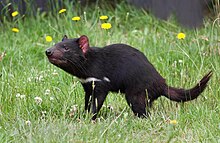Tasmanian devils
| Tasmanian devil | |
|---|---|
 |
|
| Scientific classification | |
| Kingdom: | Animalia |
| Phylum: | Chordata |
| Class: | Mammalia |
| Infraclass: | Marsupialia |
| Order: | Dasyuromorphia |
| Family: | Dasyuridae |
| Genus: | Sarcophilus |
| Species: | S. harrisii |
| Binomial name | |
|
Sarcophilus harrisii (Boitard, 1841) |
|
 |
|
| Distribution of the Tasmanian devil (grey) | |
The Tasmanian devil (Sarcophilus harrisii) is a carnivorous marsupial of the family Dasyuridae. It was once native to mainland Australia and now found in the wild only on the island state of Tasmania, including tiny east-coast Maria Island where there is a conservation project with disease-free animals.
The size of a small dog, the Tasmanian devil became the largest carnivorous marsupial in the world following the extinction of the thylacine in 1936. It is characterised by its stocky and muscular build, black fur, pungent odour, extremely loud and disturbing screech, keen sense of smell, and ferocity when feeding. The Tasmanian devil's large head and neck allow it to generate among the strongest bites per unit body mass of any extant mammal land predator, and it hunts prey and scavenges carrion as well as eating household products if humans are living nearby.
Although it usually is solitary, it sometimes eats with other devils and defecates in a communal location. Unlike most other dasyurids, the devil thermoregulates effectively and is active during the middle of the day without overheating. Despite its rotund appearance, the devil is capable of surprising speed and endurance, and can climb trees and swim across rivers.
It is believed that ancient marsupials migrated from what is now South America to Australia tens of millions of years ago during the time of Gondwana, and that they evolved as Australia became more arid. Fossils of species similar to modern devils have been found, but it is not known whether they were ancestors of the contemporary species, or whether the current devils co-existed with these species. The date that the Tasmanian devil became locally extinct from the Australian mainland is unclear; most evidence suggests they had contracted to three relict populations around 3000 years ago. A tooth found in Augusta, Western Australia has been dated to 430 years ago, but archaeologist Oliver Brown disputes this and considers the devil's mainland extinction to have occurred around 3000 years ago.
...
Wikipedia

